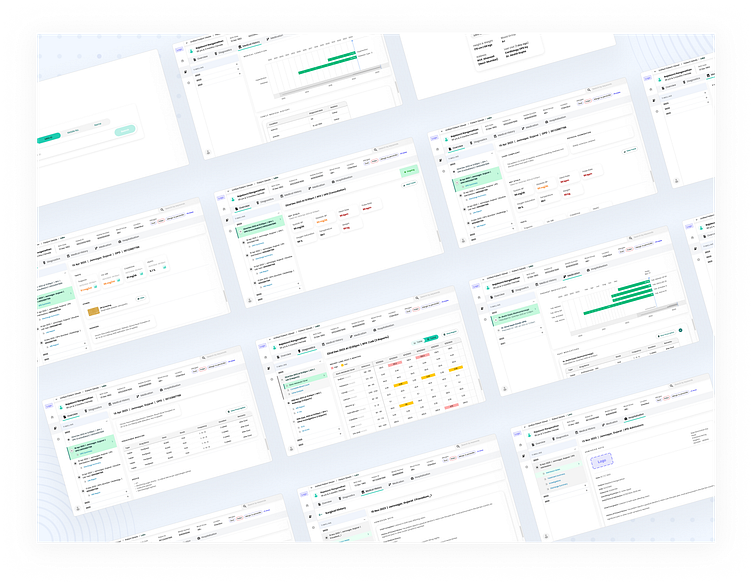Unifying Health Data Of Patients
This unified patient viewer SaaS web app exemplifies user-centered design principles and lean design thinking. It provides a comprehensive overview of patient information, streamlining workflows and enhancing care delivery. I've aimed at creating a solution that empowers healthcare professionals with highly detailed yet accessible information in a consolidated view that ultimately benefits both patients and medical professionals by fostering a more efficient and informed healthcare ecosystem.
Understanding the Need :-
Modern healthcare often involves juggling multiple systems and fragmented patient data. This can hinder efficient care and lead to information overload for medical professionals.
Applying User-Centered Design & Lean Thinking :-
1. User Research & Empathy
I conducted interviews and observations with healthcare professionals to understand their pain points regarding patient data management.
Key findings revealed a strong need for a centralized platform that presents patient information in a clear, accessible, and actionable way.
2. Defining the Need
Based on user research, I designed the unified patient viewer with the following core functionalities;
Convenient Patient Search: Effortlessly find patients using a single toggle search bar that accepts MRN (Medical Record Number), mobile number, or name.
Quick Access Patient Details: Gain a snapshot of critical patient information like DOB, ID, blood group, location, and allergies, conveniently nested for easy reference.
3. Tabbed Navigation & Sticky Timeline View
Tabbed Interface: Navigate through patient information seamlessly using intuitive tabs for Overview, Diagnostics, Medical History, Medication, and Hospitalization.
Sticky Timeline View: A persistent timeline panel on the LHS displays a chronological record of all patient health interactions, including dates and times. Users can drill down by year to view relevant details.
4. Overview Tab
Summary View: Gain a high-level overview of all patient actions and doctor actions, including discharge summaries, OPD summaries, lab reports, MRI reports, etc., presented with corresponding dates.
Right-Hand Side (RHS) View - Toggled Data
Tests & Key Vitals: View a summary of recent tests and vital signs with their values and severity ranges.
Diagnosis Details: Gain insights into patient diagnoses.
Physical Examination Details: Understand the physical examination findings.
Chief Complaint: Access the patient's primary concern during the consultation.
Trend Graph: Analyze trends in key patient health metrics over a chosen period using a toggleable graph.
5. Diagnostics Tab
Parent-Child View: The LHS timeline displays dates and times of health interactions. Nested within each date are reports provided by the medical center, such as CBC (Complete Blood Count), urine analysis, BMP (Basic Metabolic Panel), MRI reports, ECGs, and 2D echoes.
RHS View - Toggled Data
Recent Lab Tests: View a tabular format of recent lab tests (6-month aggregation) with an option to access detailed reports. This view can be toggled to a visual graph for improved data visualization.
6. Medical History Tab
LHS Navigation: Utilize the LHS for easy access to patient medical history details like admission notes, investigations, discharge summaries, and treatment summaries.
RHS Detailed Cards: View detailed information about each medical history element presented in well-organized cards.
7. Medication Tab
RHS Medication View
Medication Graph: Visualize medication use trends by year using a graphical representation.
Medication Card View: Access detailed information about all current medications, including the option to download prescriptions in a tabular format.
LHS Doctor Details: View information about the doctor who prescribed each medication, including date and time of prescription.
8. Hospitalization Tab
LHS Navigation: Navigate hospital stay details on the LHS, including admission notes, treatment summaries, and investigations.
RHS Card View: Access detailed information about each hospitalization element through exportable and shareable reports presented as cards.
Benefits for Healthcare Professionals :-
Improved Efficiency: Find and access relevant patient data quickly and easily within a single platform.
Enhanced Decision-Making: Gain a holistic view of each patient's medical history, facilitating informed treatment decisions.
Streamlined Workflow: Reduce time spent searching for patient data and improve overall workflow efficiency.
Data Visualization: Leverage graphs and trends to visualize patient health trends effectively.
Improved Communication: Facilitate communication by sharing exportable reports from the platform.
--------------------------------------------------------------------
Do check out my other work & let me know how y'all found this one ! 😄✌❤
